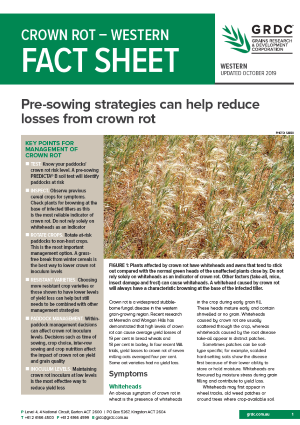Crown Rot - Western
Published: 1 Oct 2019
Crown rot is a widespread stubbleborne fungal disease in the western grain-growing region. Recent research at Merredin and Wongan Hills has demonstrated that high levels of crown
rot can cause average yield losses of 19 per cent in bread wheats and 18 per cent in barley. In four recent WA trials, yield losses to crown rot of seven milling oats averaged four per cent. Some oat varieties had no yield loss.
Key points for management
- TEST. Know your paddocks’ crown rot risk level. A pre-sowing PREDICTA® B soil test will identify paddocks at risk
- INSPECT. Observe previous cereal crops for symptoms. Check plants for browning at the base of infected tillers as this is the most reliable indicator of crown rot. Do not rely solely on whiteheads as an indicator
- ROTATE CROPS. Rotate at-risk paddocks to non-host crops. This is the most important management option. A grassfree break from winter cereals is the best way to lower crown rot inoculum levels
- RESISTANT VARIETIES. Choosing more resistant crop varieties or those shown to have lower levels of yield loss can help but still needs to be combined with other
management strategies - PADDOCK MANAGEMENT. Withinpaddock management decisions can affect crown rot inoculum levels. Decisions such as time of sowing, crop choice, inter-row sowing and crop nutrition affect the impact of crown rot on yield and grain quality
- INOCULUM LEVELS. Maintaining crown rot inoculum at low levels is the most effective way to reduce yield loss.
Download PDF
Region: West
Was this page helpful?
YOUR FEEDBACK
To protect your privacy, please do not include contact information in your feedback. If you would like
a response, please contact us.

